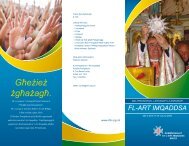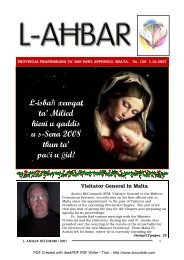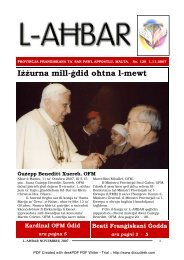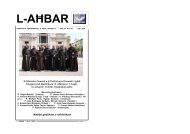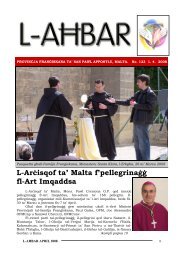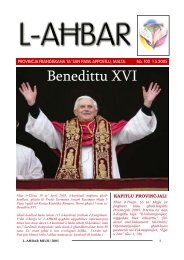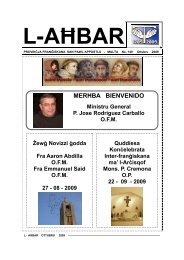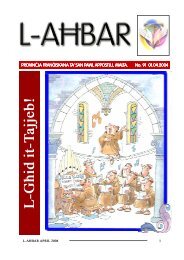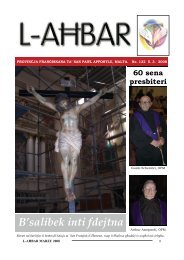L-AHBAR DICEMBRU 2005 - Franciscan Province â MALTA
L-AHBAR DICEMBRU 2005 - Franciscan Province â MALTA
L-AHBAR DICEMBRU 2005 - Franciscan Province â MALTA
- No tags were found...
You also want an ePaper? Increase the reach of your titles
YUMPU automatically turns print PDFs into web optimized ePapers that Google loves.
PROVIN¬JA FRAN{ISKANA TA’ SAN PAWL APPOSTLU, <strong>MALTA</strong>. No. 107 8.12.<strong>2005</strong>Il-Milied it-Tajjeb!L-A{BAR DIĊEMBRU <strong>2005</strong> 1
Prince of PeaceI have come to bring you peace.Not the peace of the season, for it is too fleeting.Not the peace of the carol, for it is nostalgic.Not the peace of the greeting card, for it is too slick.Not the peace of the crib, for it is too wistfulRather, I have come to bring you peace,Peace of the ordinary, the daily, the homely,Peace for the worker, the driver, the student,Peace in the office, the kitchen, the farm.I have come to bring you peace,The peace of accepting yourself as I fashioned you,The peace of knowing yourself as I know you,The peace of loving yourself as I love you,The peace of being yourself as I am who I am.I have come to bring you peace,The peace that warms you at the completion of a task,The peace that invades you at the close of the day,The peace that sustains you at the beginning of the day,The peace that reinforces you when you reconcile with another,The peace that touches you when your family is in order.Without peace, my coming is unfulfilled.Without peace, my birth is forgettable.Without peace, Christmas is a contradiction.I have come to bring you peace.NawgurawlekMilied hieni u qaddisu s-Sena 2006 tkun waħdata’ paċi u ġid.L-EditurL-A{BAR DIĊEMBRU <strong>2005</strong> 2
F’ DIN IL-{AR:ADicembru <strong>2005</strong>Motu Propju tal-Papa Benedittu XVI 4Definitorju Ġenerali 6At the School of Blessed John Duns Scotus 9Fraternitas 11The Extraordinary Ministers of the Eucharistin the early Church and in our times 15Too big for their boots 17Żjara Franġiskana fiż-Żejtun 19Ħidma mal-Baħħara 21Jingħata l-Premju Patri Martin Caruana 23Aħbarijiet u nformazzjoni 24Festafranġiskana fil-Ħamrun 26No. 107Kalendarju 2701.12.05L-A{BAR DIĊEMBRU <strong>2005</strong> 3
Motu proprio Benedict XVIRome - Vatican City 19.11.<strong>2005</strong>With the “Motu proprio” entitled “De Basilicis Sancti Francisci et SanctaeMariae Angelorum,” Benedict XVI has established new norms concerning theBasilica of St. Francis in Assisi, Italy, which is run by the Order of FriarsMinor Conventual, and the Basilica of St. Mary of the Angels in the same city,which is in the hands of the Order of Friars Minor.LETTERA APOSTOLICA MOTU PROPRIO CONTENENTENUOVE DISPOSIZIONI CIRCA LE BASILICHE DI SANFRANCESCO E DI SANTA MARIA DEGLI ANGELI IN ASSISIDa tutto il mondo si guarda con speciale considerazione alla Basilica di SanFrancesco in Assisi che conserva e custodisce le spoglie mortali del Serafico Santoe alla Basilica di Santa Maria degli Angeli, che racchiude in sé la insigne chiesettadella Porziuncola: la prima è affidata all’Ordine dei Frati Minori FrancescaniConventuali e la seconda all’Ordine Francescano dei Frati Minori.I Romani Pontefici, da parte loro, hanno sempre avuto singolari vincoli especiale sollecitudine per questi due Templi Maggiori francescani propter eorumpraestantiam atque dignitatem e li hanno voluti finora soggetti direttamente allaloro giurisdizione. Lungo i secoli i Frati Conventuali ed i Frati Minori con la lorosollecita opera e la loro testimonianza hanno tenuto vivo lo spirito ed il carisma diSan Francesco, diffondendo nel mondo intero il suo messaggio evangelico di pace,di fraternità e di bene.Considerata l’esigenza di realizzare una più efficace intesa tra le attività chesi svolgono sia nella Basilica di San Francesco (con annesso Sacro Convento), sianella Basilica di Santa Maria degli Angeli (ed unito Convento) e la pastorale dellaDiocesi di Assisi - Nocera Umbra - Gualdo Tadino, e anche con la pastoralepromossa a livello regionale e nazionale dalle rispettive Conferenze episcopali, ci èparso utile modificare l’attuale disciplina giuridica, così come regolata dal nostrovenerato Predecessore, Papa Paolo VI di f. m. mediante il M. p. “Inclita toto”, dell’8agosto 1969, per quanto riguarda la Basilica di San Francesco (con annesso SacroConvento), e mediante la Decisione ex Audientia, del 12 maggio 1966, per quantoattiene alla Basilica di Santa Maria degli Angeli (ed unito Convento),aggiornandone le norme alle odierne necessità.Disponiamo e stabiliamo pertanto quanto segue:I. Alla Basilica di San Francesco e all’annesso Sacro Convento, come anche allaBasilica di Santa Maria degli Angeli, assegniamo come Nostro Legato un Cardinaledi S.R.C., il quale, pur non godendo di giurisdizione, avrà il compito di perpetuarecon la sua autorità morale gli stretti vincoli di comunione tra i luoghi sacri allamemoria del Poverello e questa Sede Apostolica. Egli potrà impartire laBenedizione Papale nelle celebrazioni che presiederà in occasione delle maggiorisolennità liturgiche.II. Il Vescovo di Assisi - Nocera Umbra - Gualdo Tadino d’ora innanzi avrà lagiurisdizione prevista dal diritto sulle chiese e sulle case religiose per quantoL-A{BAR DIĊEMBRU <strong>2005</strong> 4
iguarda tutte le attività pastorali svolte dai Padri Conventuali della Basilica di SanFrancesco e dai Frati Minori di Santa Maria degli Angeli.III. I Padri Francescani, Conventuali e Minori, per tutte le iniziative che hannorisvolti pastorali, dovranno pertanto chiedere ed ottenere il consenso del Vescovodi Assisi - Nocera Umbra - Gualdo Tadino. Questi, poi, sentirà il parere delPresidente della Conferenza Episcopale Umbra per le iniziative che hanno riflessisulla Regione umbra o della Presidenza della Conferenza Episcopale Italiana per lequelle a più ampio raggio.IV. Quanto alla celebrazione dei sacramenti nelle Basiliche suddette valgono lenorme del Codice di diritto canonico e quelle vigenti nella Diocesi di Assisi - NoceraUmbra - Gualdo Tadino.Esorto quindi i Figli di San Francesco, cui sono affidate le due menzionateBasiliche, ad attenersi con generosa disponibilità alle norme esposte in questoMotu proprio in spirito di sincera comunione con il Vescovo di Assisi - NoceraUmbra - Gualdo Tadino e, per suo tramite, con la Conferenza episcopale regionalee con quella nazionale.Nonostante qualunque cosa in contrario.Dato a Roma, presso S. Pietro il 9 novembre <strong>2005</strong>, anniversario della Dedicazionedella Basilica Lateranense, primo anno del Nostro Pontificato.BENEDICTUS PP. XVICommunication from the Order of Friars MinorRegarding the “Motu proprio” of the Holy Father Benedict XVI of the 9th November<strong>2005</strong> for the Basilicas of St. Francis and St. Mary of the Angels in Assisi as Authorities andCustodes of the Sanctuary of the Porziuncola and of the Basilica of St. Mary of the Angelsin Assisi – entrusted by the Church to our pastoral service and animation – we wish tocommunicate officially our position regarding the recent “Motu proprio” of Pope BenedictXVI relating to the juridical and pastoral reorganisation of the above mentioned Sanctuary.As “Friars Minor” we have at heart, before all else, the annunciation of the Gospel topresent-day mankind and the reception of the many pilgrims who frequent the Basilica ofSt. Mary of the Angels and we are sure that the Church, in its wisdom and through itsactivity, proposes to protect and make known the richness of the charism of St. Francisand St. Clare, authentic witnesses – even today – to a renewed life in love, peace andreconciliation among all men and women.The experience of recent years leads us to give testimony to the existing good andfruitful collaboration between the Authorities of the Patriarchal Basilica of St. Mary of theAngels and the Diocesan Bishop of Assisi, Nocera Umbra and Gualdo Tadino, Msgr. SergioGoretti. Therefore, the new juridical disposition with its special modalities of collaboration,prescribed by the “Motu proprio”, between the Sanctuary and our Pastors, find us fully infavour of and desirous to continue such collaboration. We are confident that the measuresquoted will permit an even more profitable pastoral cooperation and efficacious ecclesiasticalcommunion between the Friars working in the Sanctuary and the diocesan anduniversal Church.We also wish to reaffirm our filial obedience to and communion with the Holy Fatherand the new Diocesan Bishop assigned by him – Msgr. Domenico Sorrentino – for the goodof the Church itself and of the People of God.Br. Massimo ReschiglianMinister Provincial OFM of UmbriaL-A{BAR DIĊEMBRU <strong>2005</strong> 5
General Definitory - November <strong>2005</strong>INFORMATION FROM THE DEFINITORYThe General Definitory held its “tempo forte” corresponding to this month from the7th to 11th November. Among the matters dealt with were the following:1. Communication. As in every “tempo forte”, the members of the Definitory gaveplenty of time to sharing on all that was done since the previous “tempo forte”:visits, work of animation, impressions. They shared their impressions of thefollowing visits: The Minister General shared his experience during the Synod ofBishops and in the plenary of the Congregation for the Consecrated Life; the VicarGeneral spoke of his participation in the Symposium held in the Vatican tocelebrate the 40 years of Perfectae Caritatis and of the meeting of the LatinAmerican Study Centres, in which he participated along with Br. Luis Cabrera;The Minister General, Br. Jacab Varnai and Br. Mario Favretto, gave theirimpressions of the fraternal visit to the <strong>Province</strong> of St. Joseph, in Belgium, and tothat of Holy Cross, in Germany; Br. Finian McGinn spoke of the meeting of theEnglish-speaking Conference and of his participation in the autumn meeting of theService for Dialogue, in which he participated with Br. Miguel Vallecillo; Br. SimeSamac presented the activity carried out in Croatia on the occasion of the openingof the VIII Centenary of the Foundation of the Order, the work of the South SlaveConference and he shared his impressions of the visit he made to all the houses offormation in Croatia together with the Moderator of Missions, Br. VincenzoBrocanelli; Br. Miguel Vallecillo shared his impressions of the work during theautumn meeting of the CONFRES Conference and of the meeting on the mission inMorocco; Br. Ignacio Muro presented the work of the Commission that is preparingthe Chapter of the Young OFM Friars; Br. Amaral spoke of his fraternal visits tothe inter-provincial house of formation in Lusaka (Zambia) and to the Custody ofZimbabwe and of his participation in the meeting of the Secretaries forEvangelisation of the African Conference; Br. Luis Cabrera spoke of hisparticipation in the International Committee of JPIC, of the meeting of the Mexico/Central America Conference and of his participation in the Congress of the<strong>Franciscan</strong> Family of Mexico, in which he participated along with Br. IgnacioMuro; Br. Mario Favretto presented what was dealt with in the COMPI Meeting andof the meeting of the COMPI and COTAF Conferences, in which he participatedalong with Br. Jacab Varnai; Br. Ambrose Van Si spoke about his visit to theFoundation of Sri Lanka and about the work of the “Forma Vitae” Commission,which is preparing the next General Chapter, in which he participated with theVicar General; Br. Miguel Vallecillo and Br. Jacab Varnai spoke about the meetingof the COTAF Conference.2. Reports on Canonical Visitations. The Definitory carefully examined andapproved the reports of the Canonical Visitations carried out during recent monthsto the <strong>Province</strong>s of The Sacred Heart, in the USA, and of St. Anthony, in Bolivia.3. Extraordinary General Chapter 2006. The following matters related to theGeneral Chapter of 2006 were dealt:The examination of the responses received to the Questionnaire, sent to the<strong>Province</strong>s and the Custodies, on the document “The vocation of the Order today”.50% of the Entities, approximately, responded. The responses will be taken intoaccount at the time of drawing up the Instrumentum Laboris of the Chapter.• The Definitory carefully examined and approved definitively the agenda of theL-A{BAR DIĊEMBRU <strong>2005</strong> 6
Chapter.•The Definitory analysed the results of the “Forma Vitae” Commission in relation tothe Instrumentum Laboris. It is expected that the General Definitory will be able tostudy and approve the Instrumentum in the month of January and that it will beready to send to all the Chapter Members after Easter.• The proposal that the biblical icon for the Chapter should be that of the disciplesof Emmaus and that the texts of reference should be the Gospel and the Rule wasapproved.4. VII Centenary. In relation to the VIII Centenary, the following was dealt with:• The Definitory evaluated the opening of the first year of preparation for the VIIICentenary of the Foundation of the Order, celebrated in Assisi on the 28th and29th October. The Definitory made a very positive evaluation of the acts,underlining, among other things, three aspects: the climate of prayer, thedimension of universality with the participation of all the Novice Masters of theOrder and the numerous participation of Friars in the acts.• The Definitory approved a project to make our historical, spiritual and culturalpatrimony known during these four years through items that will appear on theinternet.•The celebration of various exhibitions in Rome of a cultural nature during theseyears was approved.It was decided to make a DVD about the Order today, taking into account the 800years of its history.• It was decided to ask the Congregation for permission to organise a FormationCongress for the Presidents of the Federations of our Contemplative Sisters as away for them to participate in the acts organised by the Order on the occasion ofthe 800 years of our foundation.5. Bursar General’s Office. During this “tempo forte” the following topics inrelation to finances, among others, were dealt with:• The presentation, on the part of the Bursar General, of the budgets for the Curiaand other Houses dependent on the Minister General, for 2006.• The budget for Studies, which will complete the twice yearly review of thefinancial administration of the Houses dependent on the Minister General, wasapproved.•An increase in the “pro capite” tax assessment to the General Curia wasapproved.6. Justice, Peace and the Integrity of Creation. The Definitory approved theprogramme for the International Congress of Justice, Peace and Integrity ofCreation, which will be held in Uberlandia (Brazil) next year.7. The Congress of Novice Masters. The Definitory, together with the SecretaryGeneral for Formation and Studies, carried out an evaluation of the Congress ofNovice Masters, held in La Verna and Assisi, last October. The evaluation, ingeneral terms, was very positive. The Definitory gave its consent for the letter tothe Ministers Provincial and Custodes, written by the Masters at the end of theCongress, to be sent out to the Order.8. The African Conference. Accepting the desire expressed by the Secretaries forEvangelisation of the African Conference, the Definitory reflected on the selffinancingof the Entities of Africa and on the steps to be taken for this to bepossible in the future. The Definitory proposed that, for the moment, this topicshould be dealt with on the level of the Conference of Ministers Provincial.L-A{BAR DIĊEMBRU <strong>2005</strong> 7
9. <strong>Franciscan</strong>s International. The Definitory reflected on <strong>Franciscan</strong>sInternational on the basis of the information offered by our representative on the“Executive Council” of the said NGO, Br. Markus Heinze, ofm.10. The Meeting of the new Ministers Provincial. The Definitory drew up andapproved the agenda for the meeting of the new Ministers Provincial which will beheld in Rome next January.11. The Chapter of Mats of the “Young OFM Friars”. The Definitory drew upand approved the agenda for the III Chapter of Mats of the “Young OFM Friars”which will be held in the Holy Land during July 2007.12. Collaboration in financial aid. The Definitory was informed, in detail, of themeeting held in the General Curia on the 5th of the month betweenrepresentatives of the General Curia, The <strong>Franciscan</strong> Central Mission (Germanyand Vienna) and our Secretariat for Missions in the USA. It is sought, throughthese meetings, to find a way for greater collaboration between the differentorganisations and for greater transparency. The Definitory approved the procedureto follow in asking for financial help.13. Financial Help. The General Definitory, after a careful examination of therequests received, approved various financial bequests to needy Entities of theOrder.14. Other Matters. The Definitory dealt with some 50 matters, on which it had toexpress an opinion, since the last “tempo forte”.15. Meetings. During this “Tempo forte”, some members of the Definitoryparticipated in the Acts in Honour of Blessed John Duns Scotus on the occasion ofthe liturgical feast and in the festive meeting with the fraternity of St. John Laternon the occasion of the feast of the Dedication of the Basilica. The Definitoryparticipated in the meeting with the new Visitators General held in the GeneralCuria from the 14th to 19th of the month.Br. Sandro Overend, ofmSecretary GeneralOFM VIII cent.The openingEucharistat thePorziuncola29.10.<strong>2005</strong>L-A{BAR DIĊEMBRU <strong>2005</strong> 8
At the School of Blessed John Duns ScotusThe Minister General Br. José Rodríguez Carballo. OFMPUA 8th November <strong>2005</strong>Dear Brothers and Sisters who givea service to the Pontifical University Antonianum,academic authorities andstaff, dearest professors and students,May the Lord give you His peace!I thank professor Antiseri who,with his majestic lecture, guided usalong the path of a positive recovery ofcontingency. This, in fact, marks in variousways, but amply, the culture, thefeeling and the society of our times. Wesee, however, that there is a positive wayto travel it and that, as we have justheard, St. Bonaventure had already outlinedone. The Itinerarium mentis inDeum, is literally a “way”, an itinerary, apath along the contingency of the cosmosand of man, of the limitations outsideand within us, which is positivelymade into access to the Absolute, toGod. We are before the Bonaventuretranslation of the human and spiritualevent of Brother Francis who knew howto discover, listen and contemplate theMost High, Almighty, good Lord in creaturesand through creatures, and alsothere where, to the eyes of most, itseems to have been negated. Callingevery creature and the most humblethings, the realities in which the limitationsare most evident, brother and sister,St. Francis affirms the manifestationof the sovereignty and lovable paternityof God in them. He, in this way, recognisedand praised the Absolute in thecontingent: in the “creature world”, in“our sister, mother earth”, in the grass“sprouting and flowering in the morning,withered and dry before dusk” (Ps. 90,6),in all animals, even the smallest and insignificant,like the bees and the worms(cf. 1Cel 80ff), in sister ashes, eloquentsymbol of the transience and temporalityof our reality. But the limitations of manare also made a motive of praise: in theextreme fragility of brother body, in the“brothers Christian lepers”, in “our sisterbodily death”, in sisters suffering andsickness. Not even moral poverty, indeed,is subtracted from this logic, becauseFrancis knows how to transform itinto praise: for the brothers brigands, forbrother wolf, for the “poor priests of thisworld” and also for the rich who live inluxury.Thus, in the footprints of St. Francis,Blessed John Duns Scotus, duringwhose liturgical memorial we wished tohold the Inaugural Lecture for the openingof the new academic year of our University,is shown to have been very attentiveto the intrinsic value of contingencyand of the finite. He, in his famousdoctrine of the disjunctive transcendental,by affirming that every existingthing must be considered, by ontologicalnecessity, as finite or infinite,raised the finiteness of the passing manto the dignity of a transcendental predicateand since, as Scotus shows in DePrimo Principio, God is the only infinitebeing, then the finite, the possible andthe contingent, are nothing other, in acertain sense, than the most proper aspectof all that is not God, of the worldand of man. In contrast to the itineraryof St. Bonaventure, which is based onthe image and likeness of the world andof man to God, the way of Scotus to Godis based precisely on the radical differenceand otherness of the world and ofman, contingents, to God, who is infiniteand necessary.From Bonaventure to Scotus therehad only passed one generation, buttime flew even then and, in the arch ofthat generation, the way of thinking andfacing up to reality had changed radically.Augustine had passed, Aristotlehad already been imposed, but the FriarsMinor, with Francis, had continuedL-A{BAR DIĊEMBRU <strong>2005</strong> 9
to state that the world and man, no matterhow they are conceived, take theirmeaning from You, O Most High. To reachGod, Scotus seems to tells us that thecommon features between the Absoluteand the contingent must not be sought,but rather the essential and irremovabledifferences and otherness that exist betweenthe Infinite and the finite. This isthe “new” way of Scotus, who, openingup to the “laicising” and “secularising”vision of Aristotle, knew how to inscribeit in a Christian view of the world, ofman and of history, which is the <strong>Franciscan</strong>view.Blessed John Duns Scotus remindsus, in that way, that in the area ofknowledge, culture and studies also, thepossible and the contingent can constructthe condition of openness to theNecessary and the Absolute. Ratherthan being a “powerful thought”, whichruns the risk of wishing to guarantee theexistence of the Absolute – as if it wasthe power of human thought that assuredthe existence of God and not, onthe contrary, His infinity and absoluteness– Scotus proposed a humble, poor,“<strong>Franciscan</strong>” thought, which became aninvocation and a vocation, a prayer andpilgrimage, on the way to the Absolute.We include, in this setting, the particulartraditional attention which, in the<strong>Franciscan</strong> tradition, was always reservedfor the freedom and historicity ofman, for his truths, poor and yet alwaystruth.The century which we have justput behind us, the twentieth of theChristian era, linked to a twofold mandatewith rationalism and the unlimitedfaith in the capacity of reason, was thecentury of the self-styled “powerful”thoughts, of ideologies, of ambitiouslyall-encompassing world views and,therefore, of violent tendencies, of twogreat world wars and other numerousconflicts. The teaching of Duns Scotuspresents to us, on the contrary, a consciousargument for limitations and essentialadhesion to contingency andwhich is, therefore, attentive to the truthof others. Such teaching today indicates,for men of good will intent on constructinga better world, a privileged path onwhich to walk in wisdom and love. PaulVI, of venerated memory, presented,back in 1966, the Scotus doctrine in thislight: “Against rationalism – the Popewrote - [John Duns Scotus] highlightedthe limitations of reason in the knowledgeof revealed truth and the need forthe latter in order to reach the ultimateend, to which man is destined” (Paul VI,Alma parens, n. 18).“In processu generationis humanaesemper crevit notitia veritatis”, “Theknowledge of truth always grew in theprogress of the human race” (OrdinatioIV, d. 1, q. 3, n. 8): Scotus showed aprofound hermeneutical sensitivitywhich makes him a man of our timesrather than a medieval one. Almostechoing the Seraphic Doctor, who taughthow “nothing in this life can be knownfully” (“nihil in hac vita scitur plenarie”Quaestiones disputatae de scientiaChristi, q. IV, ad 22), Scotus seems toinvite us to a care for and a listening tothe other, to the different. He seems, onthe path of the progress of man, to inviteus to a pacific intellectual acceptance ofwhoever does not think like us, but whoshares our limitations, contingency, historicitywith us and, probably, the samethirst for the Absolute. In my letter TheFlavour of the Word on the intellectualvocation of the Friar Minor today, writtenon the occasion of the elevation of ourAntonianum to a Pontifical University, Iexhorted the Friars, and especially thoseengaged in studies and dialogue withcultures, to take on attitudes of respectfullistening and careful hermeneutics,attitudes that are necessary in order toaccept others and the totally Other: “Thesearch for the Life, the Truth and theGood, a limitless ocean of unendinglight, requires an impassioned, carefuland respectful intelligence since, giventhat the manifestation of the truth isnever immediate, the search can only beikompli p. 20L-A{BAR DIĊEMBRU <strong>2005</strong> 10
The Extraordinary Ministers of the Eucharistin the early Church and in our timesSebastian Camilleri, OFMBy way of information, according tothe lastest Pontifial Document:“Repemtionis Sacramentum” is notallowed to say anymore “Extraordinaryor Special Minister of the Eucharist, butExtraordinary Minister of HolyCommunion”. In order to detail the aimof this article, I wrote the usual words:“Extraordinary Minister of theEucharist“ for the time being.The extraodinary Minister of theEucharist is an aclyte or any other ofChrist’s faithful, approved by the parishpriest, according to the norms ofCannon Law.In times of necessity, on account ofthe shortage of priest, the lay Ministers,men and women, may give HolyCommunion to the congregation duringweekly and Sunday Masses and to thesick persons, hostels or housebound, onaccount of their inability to go to churchto receive the Sacraments.The laity, recommended to performwith dignity this sacred task, are calledExtraordinary or Special Ministers of theEucharist, because in accordance withCannon Law 909, the Ordinary Ministerof Holy Communion is a Bishop, a priestor a deacon.In our times, it is a common sightto see the priest, after Holy Communion,handling little silver or gold-plates pyxescontaining consacrated Hosts to theSpecial Ministers of the Eucharist tocarry them to give Holy Communion tothe sick, as our mediaval catholicancestors did carry the BlessedSacrament to the sick in a “Chrismal”made of a cloth, like a folded Corporal,as used at Mass.St. Columbanus (550-625)prescribed penalities for dropping thechrismal, accidently or leaving it behindthrough negligence. The Special Ministerof the Eucharist has a remarkabel andentailing task that, historically, goesback to the command of Our Lord whotold the twelve apostles to “heal thesick”, St. Matthew (X.8). In theCatechism of the Church, Pope JohnPaul II tells us “The Church beleives inthe life-giving presence of Christ, thephysician of souls and bodies. Thispresence is particularly active throughthe Eucharist, the bread that giveseternal life and that St. Paul suggests, isconnected with bodily health” (1 Cor.11,30).Indeed the ordinary minister of theSacraments is a priest who alsoadministers Holy Communion to thesick of the parish in their homes,hospitals and hostels. St. Justin,martyr, (100-165) in his descrition ofChristian Beliefs to the EmperorAntoninus Pius (140 AD), says “that thedeacons give communion to each ofthose present and carry away theconsecrated bread and wine and waterfor those unable to attend” (Apology, I,65).In the early centuries ofpersecutions, when it became impossiblefor christians to meet at Mass orcongregate in public withoutendangering their lives, it was normalfor lay people, men and women, to takethe consacrated bread at Mass, to givethemselves Holy Communion at theirhomes. “The early christian receivedHoly Communion under both species,bread and wine. To those who could notbe present at the meeting because ofsinkness or infermity, it was carried bythe deacons. Christians were permittedto keep the Blessed Sacrament in theirhomes, or to carry it with them onjourneys” (The Story of the Church. ByReverends G. Johnson & J. Hannan.Tan Books & Publihers, Inc. Illinois,USA. P.49).Writing at Carthage in 192 AD,Tertullian (166-220 AD) refers to thispractice saying that reception of theBlessed Sacrament seems to have beenL-A{BAR DIĊEMBRU <strong>2005</strong> 11
frequent in the early Church when awoman would receive the Eucharist, athome, in secret, before taking any food(A Uxorem 115, Patres Latini. Migne 1Col 1296).The young acolyte, St. Tarcisiuswas stoned to death, murdered, becausehe was found carrying the BlessedSacrament to christian prisoners. Hisdeath, in 175 AD, in Rome, rather thansurrender the Sacrament to profanationin the hands of a hostile mob, is firstmentioned by Pope Damasus (304-384AD) in his Epigramata, who said “braveTarcisius died carrying about hom theSacrament of the Body of theLord” (Elogium 15 Romae, 1942 pp. 117-119).Eusebius of Caesarea (260-340)speaks of a dying christian man whosent for a priest to give him HolyCommunion and the BlessedSacrament, which must have beenpreserved in the Church, was taken tohim (Ecclesiastical History VI 44).St. Paulinus of Nola (333-431)witnessed St. Ambose, Bishop of Milan(330-397), receiving Holy Viaticum in hisown residence while close to death. (VitaSancti Ambrosii by Paulinus of NolaXLVII). Though rarely, this seems tohave been permitted to celebrate Massin the home of a sick person. As amatter of fact, Paulinus of Nola had analtar in his chamber so that he couldoffer Mass up until his death (431 AD).At the time, the formula used foradminstering Holy Communion to thesick, in an ancient Ambrosian OrdoMissae, states: “Corpus Domini NostriJesu Christi, Sanguino Suo inlitumintinctum, mundat te ab omni peccato,i.e., May the Body of Our Lord JesusChrist dipped and annoited in his Blood,cleanse you form every sin.”During the time of persecution (64-313), when to be a christian wasconsidered to be a “criminal offence”against Rome, the box in which theBlessed Sacrament was carried to thehomes of the christians,, was called“arca”. The “pyx” was also used butcould mean the “tabernacle”, whichtoday we have in our churches. It ispresumed that the pyx was left at thehome, so that the sick and otherchristians present, could receive HolyCommunion.With the cessation of thepersecutions and people could openlyprofess their faith, sadly, abuses creptin .Some heretics pretended to take HolyCommunion, but privately took theSacred Hosts away for various unworthypurposes. (Council of Caesarangustiana-Saragossa 380 AD. Can.III, Council ofToledo 4090 AD. Can.XIV).This profonation of the consacratedHosts, was condemned by two Councilsin 380 and 400. St. Cyprian, Bishop ofCarthage, in 251 AD., speaks of awoman who tried “with unworthy handsto open the pyx in which the Body of theLord was kept and she was deterred by afire rising up out of it. (De LapsisCXXXII).Such abuses led to prohibitions ofleaving the Blessed Sacrament inhomes. The Council of Caesarangustiana(380 AD) declared anathemaanyone who only pretended to take HolyCommunion, after receiving the SacredHost at Mass. A priest chronicler,Reginon, (915) wrote: “that the sacredOblation be reseved in the church, only,for the Viaticum for persons in danger ofdeath (De disciplinis Ecclesiasticis, I,70).While abuses led to restrictions tolay persons to keep consacrated speciesin their homes, after the Edict of Milan(315 AD), the practice of taking HolyCommunion to the sick and dying hascontinued unabated as from thebeginnings of our faith until the presentday. The Viaticum that sustained ourancestors in the faith will be brought tous when the end of our lives is near.Bede the Venerable describes how thefamous Saxon Christian monk-poet,Caedmon, who died in 680, received “theheavenly viaticum in his hand on hisdeath-bed” (Historia Ecclesiastica, IV,24).At the Council of Nicea in 325, wasagreed that none of the baptised, even ifL-A{BAR DIĊEMBRU <strong>2005</strong> 12
they lapsed, should be denied HolyViaticum be brought to them at themoment of death. This practice wasextended to apostates, even if at the timeof their death, had not yet completed thepenance imposed, though if they wouldrecover they were obliged to continuetheir penance. Cardinal Giovanni Bona(1609-1674) describes this as thepractice of the Church acceptedeverwhere (Rerum Litterarum I.C.XXI, #2).During the upheaval of the Reformationin England, it is worth notingthat Pope St. Pius V had allowed MaryQueen of Scots—who was imprisoned onMay 16, 1568, for twenty years by hercousin Queen Elizabeth - to give herselfHoly Communion which she did untilshe was executed on February 1587.(Charles-Rene Billuart 1685-1757, DeEucharistia diss. VII a.8). It is thus assumedthat a number of consecratedhosts were brought to her, periodically,by Special Ministers of the Eucharist ora priest, all the years she spent inprison.The time-honoured custom ofcarrying the body of Christ to the sick,which is a daily practice in our churchtoday, is a dear remembrance of Christ’scompassion for the sick; this is theirperrenial hope of eternal life. AsCharlemagne, crowned by the Pope LeoIII, on Christmas Day 800, as first HolyRoman Emperor in St. Peter’s Basilica,said: “This Eucharist Mystery issometimes called Viaticum, because ifanyone enjoys it on the way, he willarrive at that life which he already haswithin himself.” (Liber VII,101).Thus the Church in her mercy,from the beginning and through thecenturies, has provided all possibilitiesthat the infirm faithful could receive theBody of Christ in Holy Communion indanger of death, either by priests orextraordinary ministers of the Eucharist.Too big for their bootsDionysius Mintoff, OFMIn my youth, children were seen and not heard. They spoke when they werespoken to. They asked leave to take an apple. They expected to clear up themesses made in their own play. They were small fry and knew it.They knew because adults made plain to them their unimportance in life.Privileges, they were told, would come "when you earn your own living". Or,perhaps, "when you are married". Freedom came to those who paid their own way.For children, dependent on the work of others for everything, life followed a properpath of education, of training and of discipline. They were oppressed poor things.Their individual development was stultified. Their egos were frustrated, their freeexpression was inhibited.They were so downtrodden, poor little dears, that they never had a chance inlife. Yet, they won two world wars. In adult life they showed initiative, originalityand individuality that is rarely found in youngsters today.Just think over the list of those whose full development was "frustrated"through the "repression" of old-fashioned upbringing: Churchill, Scott, Irvine andMallory, Lawrence, Russell, Wallace, Allcock and Brown, Munnings...Downtrodden? Fiddlesticks! Behind the great men followed the cohorts ofcompetent administrators and workmen. They civilised half the world. Theybrought the nation to its highest peak of prosperity. A people, who understoodclearly that children are seen and not heard, did all this.No one section of the people was responsible for the establishment andmaintenance of the inferior place of children. It was the established order of thingsand reflected the general climate of public opinion. All adults treated all children inthe accepted way.L-A{BAR DIĊEMBRU <strong>2005</strong> 13
Parents (perhaps I should say most parents) taught their children to respect thehead teacher and the priest. The teacher taught children to respect their parentsand, in Church schools, the priest or sister. The clergy taught children to respecttheir parents, their teachers, their eldest and their betters.My impression is that this upbringing fostered initiative, individuality and thespirit of adventure, rather than suppressed it. Mischief and devilment were, if Iremember rightly, more evident then than now.Naturally enough, for a firm and proper discipline encourages any worthwhilechild to express his individuality in rebellion. I am sorry for our present generationof children. From the age of two upwards they are allowed to do very much as theylike. Freedom has been handed to them on a plate. Like most free gifts, it is notappreciated.What youngster now looks forward to "the key of the door" at 21? Most ofthem have a copy cut when they are 15, leave it at home and wake up father to letthem in at midnight.Denied a proper discipline in life, our present-day children have nothing torebel against. I believe that unearned freedom saps initiative, destroysindividuality and "encourages living soft" instead of living "adventurously". Sohaving had unearned freedom thrust upon them as children, they find noresponsibilities in freedom as adults.This is the new established order. Again, no one section of the people can beheld responsible. Parents teach children their "rights" including the right to sue ateacher for assault. Teachers have their work cut out to teach children to respectteachers, let alone anyone else. Priests... well, how many children now come underthe influence of a priest at all? I can only record that the influence of the churcheshas declined; and the nation is poorer for it.Although, the whole community shares responsibility for the presentsituation, the educated minority must bear the major share. It was not theworking man who started his children down the slippery slope from properdiscipline to silly freedom. He rebelled against it, unthinkingly of course. But thediscipline that was good enough for his dad, was good enough for him and so goodenough for his children too.It has taken the "enlightened" thinking minority about 50 years to alter"working class" thoughts about the upbringing of children. The better educatedparents are the more "enlightened" they seem to become and the worse theirchildren seem to be brought up. The "ordinary" parent has not been given achance. He has seen the children of educated people brought up as twins to thefamily cat and dog. He has been told by inspectors, by sentimental social workers,by juvenile courts and by some teachers that discipline is bad. It has taken 50years but it has worked. The children of all social levels are now equally spoiled byexcess freedom.If things are to be changed, the lead must come once again from the top, fromthe educated people. Even if there is a lead, it may take another 50 years to restorea proper attitude to children.Luckily, there are signs that the proper place of discipline in education is stillunderstood by some people. Even more welcome is evidence that influential officialopinion is beginning to wonder whether freedom has been overdone.The educational system must bear its share of blame for the uselessness ofmany of today's youngsters. Schools have rightly set out to develop fully theindividual potentialities of every child. Unfortunately, a fault has crept into thereasoning between the end to be achieved and the means of achieving it. A childdoes not develop his full individuality through being given life on a plate, to use ashe chooses.L-A{BAR DIĊEMBRU <strong>2005</strong> 14
Il-programm taż-Żjara tana wkoll iċ-ċans li niltaqgħu mal-grupp ta’ l-abbatini, u l-adoloxxenti bniet u subien li jiltaqgħu fiċ-Ċentru Nazju Falzon.Kull Żjara tirnexxi jekk hija ssapportjata mill-Kappillan u l-Kleru. Sibna akkoljenza ukollaborazzjoni ottima fl-Arċipriet, Dun Eric Overend, u l-kleru kollu taż-Żejtun, li lkolltawna eżempju mill-isbaħ ta’ kollaborazzjoni saċerdotali u pastorali.Fis-17 ta’ Novembru fit-8.00pm kelli laqgħa ta’ evalwazzjoni taż-Żjara ma’ l-Arċipriet DunEric Overend u l-Viċi Dun Victor Scicluna: urew l-apprezzament sħiħ tagħhom għallħidmakollha matul iż-Żjara. Iddiskutejt magħhom it-tlett karatteristiċi prinċipali ta’ din iż-Żjara, kif miktub hawn fuq. Huma apprezzaw il-preżenza ‘fran;iskana’ ta’ matul iż-Żjara ux-xhieda ta’ sempliċità u ta’ ħidma flimkien li tajna. Iż-Żjara dehret bħala tħaddim talkariżmafran;iskana għall-;id ta’ Knisja partikulari, dik taż-Żejtun.Flimkien fittixna mod kif nagħmlu follow-up taż-Żjara u pproponejna li f’xi weekend, forsidak marbut maċ-ċelebrazzjoni ta’ l-Ewwel Tqarbina, ner;għu mmorru grupp minna unagħmlu weekend ta’ katekeżi fuq is-Sagrament tar-Rikonċiljazzjoni flimkien maddisponibiltàli noffru l-ħin tagħna għaċ-ċelebrazzjoni ta’ dan is-Sagrament. Dan il-followupjista’ jkun it-twettiq tal-proposta li ;ieli iddiskutejna flimkien rigward ‘mini-Żjara’ litieħu aspett strettament kateketiku u ċelebrattiv.Nikkonkludi din l-evalwazzjoni qasira bit-tama li dalwaqt niltaqgħu biex niddiskutuhaflimkien u nippjanaw għall-futur. Bħal dan iż-żmien sena ilu konna er;ajna bdejna l-esperjenza taż-Żjara Fran;iskana fil-Parroċċa ta’ Bormla. Ma’ din il-parroċċa żorna wkolliż-Żurrieq u ż-Żejtun. Nesprimi f’isimkom il-gratitudni kbira lejn il-Missier tagħna tassemau lejn xulxin għal din l-esperjenza li kienet għalina lkoll ta’ ;id u ta’ barka.ikompli minn p.10a ceaseless hermeneutics or interpretation” (The Flavour of the Word, 3.1).I hope that the passion to seek the “Way, the Truth and the Life” can inflamethe minds, as well as the hearts, of all who approach <strong>Franciscan</strong> thought in generaland, in particular, that of Blessed John Duns Scotus. I would especially like toremember the Friars who work humbly, hidden, but with great love, in the InternationalScotus Commission. The thanks of the entire Order goes to them for allthey have done up to now and because they are giving us the work of a Friar, who,through his thought, has profoundly marked our way of being Friars. I hope thatall, while we prepare to celebrate the VIII Centenary of the birth of our charism,may learn from Blessed John Duns Scotus how to live it in fidelity, knowing creatively,however, how to make it significant for our times.• Unjust criticism is often a disguised compliment. Itoften means that you have aroused jealousy andenvy. Remember that no one ever kicks a dead dog.• Do the very best you can; and then put up your oldumbrella and keep the rain of criticism from runningdown the back of your neck.L-A{BAR DIĊEMBRU <strong>2005</strong> 16
hom, jinqraw il-minuti tal-laqg]a ta’ qabel u jag]mlu s-su[[erimenti tag]hom. Dan l-a]]ar kellna \ew[ membri[odda u li b’kollox issa hemmg]axar membri. Okka\jonalmentsaru ]ar[iet f’xi ristorantb]ala rikonoxximent tax-xog]olvoluntarju. Barra minn hekkqed isir ukoll xog]ol ta’ \ebg]au manutenzjoni fil-kamra flewwelsular tad-dar konnessamal-knisja ta’ Liesse li hija l-Headquarters ta’ l-Apostolat.Inxtraw ukoll is-si[[ijiet g]aldan il-g]an. Hemm relazzjonitajba ma Fr. Alfred Vella, iddiretturtal-Kummissjoni Emigranti,u ma’ Mons. PhilipCalleja, delegat ta’ l-Ar`isqof kifukoll mal-Provin`jal Fra PawlGalea ofm, li [ew mistiednabosta drabi g]al laqg]at.SEMINARIl-}amis, 31 ta’ Marzu,<strong>2005</strong> kellna laqg]a spe`jali fiddarta’ l-Irtiri “Manresa” [ewwaG]awdex. Organi\\ajna seminarta’ [urnata fuq l-Islam u r-reli[jon Musulmana. IL-kelliemikien Fr. Steno De Raffaele S.J. lihu istruwit ]afna fuq dan is-su[[ett min]abba l-fatt li g]ex g]al \mien twil [ewwa l-Indja fejnkien g]alliem ukoll.L-IMPENN TAL-MEMBRIIl-membri j[eddu l-impenn tag]hom fil-Festa tal-Madonna ta’ Liesse.Wie]ed mill-membri jag]ti tag]rif [enerali dwar l-Apostolatwara l-omelija, imbag]ad jissej]ul-membri kollha quddiemi`-`elebrant u j[eddu l-weg]datag]hom. B’hekk il-komunita’tag]raf tapprezza aktar din il-]idma.TIFKIRA TAL-KONVOYTA’ SANTA MARIJAKull sena, il-membri ta’ l-Apostolat tal-Ba]ar jorganizzat-tifkira tad-da]la tal-Konvoyta’ Santa Marija fil-Port ta’Malta. Huwa servizzekumeniku li jsir fix-Xatt tad-Dwana. Hija tradizzjoni li ilhassir g]al ]afna snin u g]aliha ji[u mistiedna diversiasso`jazzjonijiet u exserviceman.Hija okka\joni fejnisir talb g]al dawn l-eroj litaw ]ajjithom g]al pajji\na.PINTO WHARF U L-KAPPELLATAL-}ARBA TA’ L-E{ITTUF’Di`embru li g]adda,Fra Paul Attard [ie avvi`inatmill-Uffi`jali tal-VISET li ]aduf’idejhom il-pro[ett ta’ PintoWharf fejn urew ix-xewqa li l-Kappella ddedikata lil }arba ta’l-E[ittu tg]addi f’idejn l-Apostolat tal-Ba]ar. Flimkienmal-Mons. Philip Calleja iltaqg]u bosta drabi ma’ uffi`jali g]olja u [ie diskuss il-possibilta’ta’ dan is-servizz. Sar ftehim lis-servizz f’din il-kappella jibdaf’{unju <strong>2005</strong> meta ji[i inawguratl-ewwel fa\i ta’ dan ilkumpless.G}ELUQDan ir-rapport fih [abrata’ esperjenzi li g]addejt minnhommatul din is-sena li ilnikappillan tal-port. Kienet senamimlija barkiet. Lil Alla rajtuf’a]wa ta’ nazzjonalitajiet diversi.Ma nistax ma’ nroddx ]ajr lil Alla u lil ommna Marija tadan. Kelma ta’ radd il-]ajrtmur ukoll lil Kummissjoni ta’ l-Emigranti li ta]thom jaqa’ l-Apostolat tal-Ba]ar. Lil MonsPhilip Calleja u Fr. Alfred Vellata’ l-g]ajnuna finanzjarja ta’kull xahar. Ming]ajrha \gurma’ jkunx possibli li jinxtara ujitqassam dan il-materjal li huta [id spiritwali g]al ]utna l-ba]]ara. A]na grati ]afnawkoll lejn l-awtoritajiet `ivili talkoperazzjonitag]hom kif ukolllejn il-Provin`ja Fran[iskana lifdat f’idejna dan l-Apostolat.L-A{BAR DIĊEMBRU <strong>2005</strong> 18
Jingħata l-Prempju Patri Martin CaruanaF’ċerimonja fil-knisja ta’ San Martinfil-Baħrija, Fra Dijonisju Mintoff, OFM,ingħata l-Premju Patri Martin Caruanagħas-sena <strong>2005</strong>.Il-premju mogħti mill-FondazzjoniPatri Martin Caruana f’għeluq il-ħamessnin mill-mewt tiegħu, jingħata bħalarikonixximent lil saċerdot, reliġjuż jewreliġjuża, għall-impenn tagħhom ta’ ħidmafis-soċjeta’ Maltija jew fil-missjoni.Fra Dijonisju Mintoff iddedika ħajtugħall-ħidma ma’ l-emar;inati fis-soċjeta’bit-twaqqif tal-Laboratorju tal-Paċi, ħidmafost ir-refuġjati u b’diversi kitbiet uxogħolijiet letterarji.Flimkien naqsmu l-ferħtal-MiliedIs-Sibt, 17 ta’ Diċembru <strong>2005</strong>Għall-Aħwa tal-ProvinċjaKunvent Santa Marija ta’ Ġesu’,Valletta10.30 a.m.Il-Ġimgħa, 30 ta’ Diċembru <strong>2005</strong>Għall-Ġenituri u l-Qraba ta’ l-AħwaPorziuncola Retreat House,Baħar iċ-Ċagħaq6.00 p.m.L-A{BAR DIĊEMBRU <strong>2005</strong> 19
Maintenance works at Sliema SanctuaryHSBC Cares for Malta's Heritage Fundhas presented a donation to GuardianBrother Stephen Magro OFM, towardsthe maintenance works being carried outon the internal stonework and walls ofthe sanctuary dedicated to Our Lady ofthe Sacred Heart in Sliema.Our Lady of the Sacred Heart Sanctuary,better known as the Sacre Coeur church,was built in 1877 in Romanesque style.The sanctuary was the result of hardwork by Fr Paul Vella to meet thespiritual needs of the growing populationof Sliema. Extension works began in1934 and took two years to finish andthe sanctuary now carries a Baroquestyle.During the last war, the sanctuary washeavily damaged. The friary wasLorna Farrugia from HSBC's Heritage Fundpresenting the sponsorship to Bro. StephenMagro OFM in the presence of Fr GeorgeBugeja OFM, parish priest of Our Lady of theSacred Heart Sanctuary and Tania Bonello,HSBC Sliema branch manager, in front of themasterpiece, Saint Jerome by Calì.completely destroyed but the friars remained in their parish to attend to the needsof the people.The sanctuary also houses some works of art by famous painters includingCalabrese painter Mattia Preti (1613-1699) and the greatest modern Maltesepainter, Giuseppe Calì (1846-1930). In fact, church visitors may admire the SaintJerome altar painting which art critics consider as his masterpiece. TheMartyrdom of St Lawrence also shows Calì at his best.The sanctuary is also adorned with a set of 13 Bohemian cut glass chandeliers andthe wall is covered with fine red damask tapestry. The statue of Our Lady of theSacred Heart is the work of the Maltese sculptor Jerome Darmanin and isconsidered to be one of the finest statues of the Virgin and Child on the Island.JINSABU RIKOVERATISERVIZZ IT-TERRA SANTAFra Charles Wickman, OFM jinsabrikoverat fl-isptar Zammit Clapp, SanGiljan. Wara l-perjodu f’dan l-isptarhuwa se jkun il-Little Sisters of the Poor,il-Ħamrun.Fra Raymond Camilleri, OFM jinsabrikoverat fl-isptar San Luqa M5.Inħeġġu lill-Aħwa biex jitolbu għalihomu jżuruhom.SERVIZZ IL-LIBYAFra John Muscat, OFM jinsab l-ArtImqaddsa biex jagħti s-servizz tiegħu fis-Santwarju ta’ Nażaret.GĦALL-VAGANZI F’<strong>MALTA</strong>Fra Raymond Falzon, OFM li qedjagħmel l-istudji dwar id-Djologu Inter-Religjuż, fl-Islamolo;ija u l-Għarbi fl-Eġittu għandu jasal Malta għal ftitġranet matul il-vaganzi tal-Milied.Fra Gustino Sciortino, OFM fil-ġranet li OPERATIġejjin sejjer jagħti s-servizz tiegħu matull-istagun tal-festi tal-Milied f’Benghazi, Riċentement Fra Kerubin Galea, Frail-Libya.Ġwann Micallef u Fra Raymond Sciclunaġew operati. Nawgurawlhom ilkoll fejqanta’ malajr.L-A{BAR DIĊEMBRU <strong>2005</strong> 20
festafranġiskana fil-fraternita’ tal-ĦamrunNhar it-Tlieta, 29 ta’ Novembru, il-fraternita’ franġiskana tal-Ħamrunorganizzat festafranġiskana għall-aħwa franġiskani fil-Ħamrun. Ta’ minjgħid li fi Triq Villambrosa, il-Ħamrun, hemm tliet fraternitajiet, jiġifieri s-Sorijiet Franġiskani tal-Qalb ta’ Ġesu’ (Fra Diegu), is-Sorijiet tal-Qalb BlaTebgħa ta’ Marija (magħrufin ukoll ta’ l-Egittu) u l-aħwa l-patrijiet.26 patrijiet u sorijiet iltaqgħu għall-Għasar Solenni fejn il-MinistruProvinċjal għamel riflessjoni. Wara ġiet organizzata pasta night. Kemmil-refitorju u anke fil-kunvent inħoloq ambjent sabiħ. Kien mument fejn l-aħwa saru jafu lil xulxin, kif ukoll mument, kif jgħid is-salmista: “kemmhi ħaġa sabiħa u ħelwa li l-aħwa jgħammru flimkien... Hemm il-Mulejjagħti l-barka, hemm hu jagħti l-ħajja ta’ dejjem.” (Salm 133) Ilkoll urewl-apprezzament tagħhom, u wrew ix-xewqa li ħaġa bħal din tiġiorganizzata minn żmien għal żmienL-A{BAR DIĊEMBRU <strong>2005</strong> 22
26 27 28 29 Festa tal- 30 Te Deum 31Familja Mqaddsa LaudamusParty għallfamiljariS. MagroFesta ta’ Mons.PorziuncolaNOVENA 19 NOVENA 20 NOVENA 21 NOVENA 22 NOVENA 23 24 25IT-TWELID TA’SIDNA ĠESU’KRISTU12 13Festa Publika14 NOVENA 15 NOVENA 16 NOVENA 17Party tal-Miliedgħall-AħwaKunvent - BeltNOVENA 18IV ĦADDAVVENT5 6 7 8L-Immakulatatal-Madonna9 10Festa ta’Fra Lorrie11III ĦADDAVVENT1 2 3 4II ĦADDAVVENTD I Ċ E M B R U 2 0 0 5L-A{BAR DIĊEMBRU <strong>2005</strong> 23IT-TNEJN IT-TLIETA L-ERBGĦA IL-ĦAMIS IL-ĠIMGĦA IS-SIBT IL-ĦADD
FESTI U BIRTHDAYSDI?EMBRURiċentement Mons. RobertCamilleri, OFM, ikkonsagra l-kappella tal-Convento SanFrancesco, li l-Provinċja ta’ l-Immakulata Kunċizzjoni (USA)għandha f’Ruma.10 Fra Lorrie Zerafa 1 Fra Alfred Sciberras25 Fra Noel Muscat 3 Fra Noel Muscat26 Fra Stephen Sciberras 4 Fra Marcellino Micallef26 Fra Stephen Magro 11 Fra :wann Micallef27 Fra :wann Schranz 17 Fra Charles Tonna31 Mons. Sylvester Magro 17 Fra Ray Scicluna19 Fra Godfrey Micallef29 Fra Pietru Pawl Meilak31 Fra Sebastian CamilleriJANNAR7 Fra Karlu Tonna 7 Fra Kerubin Galea8 Fra Arturu Azzopardi 8 Fra Adrian J. Cachia16 Fra Marcello Ghirlando Fra Mark Ciantar20 Fra Sebastian Camilleri 9 Fra Charles Grech27 Fra Julian Sammut 15 Fra Kamillu Aquilina31 Fra Sandro OverendAwguri u Xewqat Sbieħ!Librerija Bernard Bartolo OFMNhar il-Ħadd 27 ta' Novembru <strong>2005</strong>, l-Ewwel Ħadd ta' l-Avvent, ġiet inawgurata librerija ta' kotba spiritwali għall-użutan-nies li jiffrekwentaw iċ-Ċentru Pastorali Ġesu' l-Ħabib.Din il-Librerija ġiet imsemmija Librerija P. Bernard Bartoloofm, b'tifkira ta' P. Bernard li ħadem bis-sħiħ għal bosta sninu kien ukoll strumentali biex inbniet fis-sena 1993. Kienxieraq li b'tifkira għażiża tiegħu din il-librerija tiġi ddedikatagħalih.EDITURfra marcellino micallef ofmprovofm@vol.net.mtIl-librerija hija magħmula minn mitejn u ħamsa u sebgħinktieb li jvarjaw minn kotba dwar Alla, Ġesu' Kristu u l-Ewkaristija, il-Madonna, il-Knisja, is-Sagramenti u d-DuttrinaSoċjali tal-Knisja. Kotba dwar ħajjiet tal-qaddisin u kitbiettagħhom. Kotba ta' meditazzjonijiet u spiritwalita' kif ukoll Kunvent Tal-Franġiskanidwar il-Bibbja. Hemm ukoll rokna għat-tfal. Għal dan ilproġettħadmu bis-sħiħ għal aktar minn xahrejn sħaħ issinjuriJosephine Libreri, Marcell Chetcuti Navarro u VictorValletta VLT 07291, Triq San Pawl,Grech. Sejra tkun miftuħa darbtejn fil-ġimgħa, nhar ta' Tnejnfilgħodu mill-10.00am sal-11.00am u nhar ta' Ħamis waranofs inhar mill-4.45pm sal-5.45pm. Numru kbir ieħor ta' Tel. 21238218 Fax. 21231266kotba għadhom deħlin minn żmien għal żmien u jinsabu filproċessta' l-għażla u l-katalogar.L-A{BAR DIĊEMBRU <strong>2005</strong> 24







